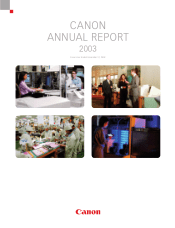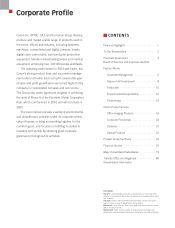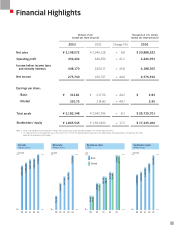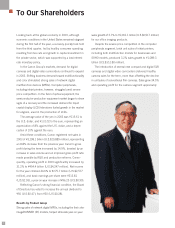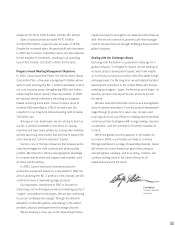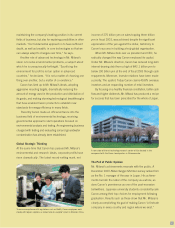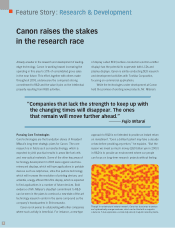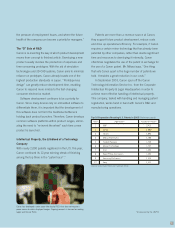Canon 2003 Annual Report Download - page 4
Download and view the complete annual report
Please find page 4 of the 2003 Canon annual report below. You can navigate through the pages in the report by either clicking on the pages listed below, or by using the keyword search tool below to find specific information within the annual report.
To Our Shareholders
Looking back at the global economy in 2003, although
economic conditions in the United States remained stagnant
during the first half of the year, a recovery quickly took hold
from the third quarter, led by healthy consumer spending
resulting from tax cuts and growth in capital investment in
the private sector, which was supported by a low-interest
rate monetary policy.
In the Canon Group’s markets, demand for digital
cameras and digital video camcorders continued to expand
in 2003. Shifting business demand toward multifunctionality
and color stimulated strong sales of network digital
multifunction devices (MFDs). Computer peripherals,
including inkjet printers, however, struggled amid severe
price competition. In the field of optical equipment, the
semiconductor-production equipment market began to show
signs of a recovery and the increased demand for liquid
crystal display (LCD) televisions fueled growth in the market
for aligners, used in the production of LCDs.
The average value of the yen in 2003 was ¥115.61 to
the U.S. dollar, and ¥131.02 to the euro, representing an
appreciation of 8% against the U.S. dollar, and a depre-
ciation of 10% against the euro.
Amid these conditions, Canon registered net sales in
2003 of ¥3,198.1 billion (U.S.$29,889 million), representing
an 8.8% increase from the previous year. Canon’s gross
profit during the term increased by 14.9%, boosted by an
increase in sales volume and an improved gross profit ratio
made possible by R&D and production reforms. Conse-
quently, operating profit in 2003 significantly increased by
31.2% to ¥454.4 billion (U.S.$4,247 million). Net income
for the year climbed 44.6% to ¥275.7 billion (U.S.$2,577
million), and basic earnings per share were ¥313.81
(U.S.$2.93), a year-on-year increase of ¥96.25 (U.S.$0.90).
Reflecting Canon’s strong financial condition, the Board
of Directors has voted to increase the annual dividend to
¥50 (U.S.$0.47), from ¥30 (U.S.$0.28).
Results by Product Group
Strong sales of network digital MFDs, including the first color
imageRUNNER (iR) models, helped stimulate year-on-year
sales growth of 3.7% to ¥1,061.1 billion (U.S.$9,917 million)
for our office imaging products.
Despite the severe price competition in the computer
peripherals segment, brisk unit sales of inkjet printers,
including both multifunction models for businesses and
SOHO models, produced 3.2% sales growth to ¥1,089.3
billion (U.S.$10,180 million).
The introduction of several new compact and digital SLR
cameras and digital video camcorders delivered healthy
camera sales for the term, more than offsetting the decline
in unit sales of conventional film cameras. Sales grew 34.5%
and operating profit for the camera segment appreciably
2

